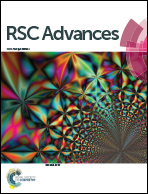An electronic tongue based on conducting electrospun nanofibers for detecting tetracycline in milk samples
Abstract
The development of novel and portable chemical sensors aimed at the food industry is of prime importance for food safety issues, and nanomaterial science can greatly contribute to this task. In this context, a careful choice of the sensing material is essential for achieving high performance sensor arrays, such as those employed in nanostructured electronic tongues (e-tongues). In the current work, an impedimetric e-tongue based on gold interdigitated microelectrodes (IDEs) modified with polyamide 6/polyaniline (PA6/PANI) electrospun nanofibers was developed, characterized and used to detect tetracycline (TC) residue in fat and skimmed milk samples. By analyzing the electrical resistance data collected by the e-tongue, which were treated by Principal Component Analysis (PCA), the e-tongue was able to identify the presence of TC residues (from 1 to 300 ppb) in fat and skimmed milk samples. The results obtained demonstrate the ability of the approach of modifying IDEs with conducting electrospun nanofibers to be used as sensing units in the e-tongue, aiming to analyze complex matrices such as milk without any prior pre-treatment.


 Please wait while we load your content...
Please wait while we load your content...